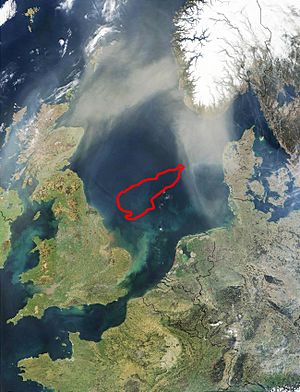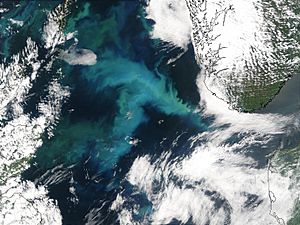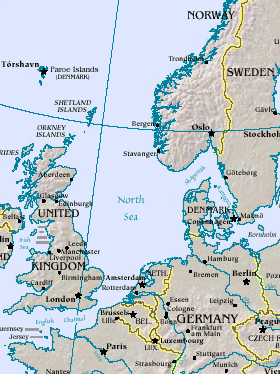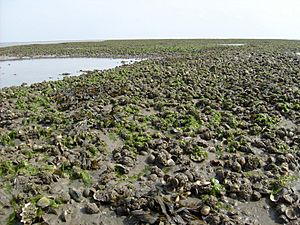North Sea facts for kids
The North Sea is a large sea in northern Europe. It's part of the huge Atlantic Ocean. This sea sits between several countries: Norway and Denmark to the east, Scotland and England to the west, and Germany, the Netherlands, Belgium, and France to the south.
Contents
Where the North Sea Is
The North Sea is connected to the Baltic Sea by a narrow waterway called the Skagerrak. To the south, it flows into the English Channel, which is the sea between England and France. The narrowest part of the English Channel is called the Strait of Dover, and it's one of the busiest places in the world for ships!
The northern edge of the North Sea opens up to the wider Atlantic Ocean. Imagine a line from northern Scotland, past the Shetland Islands, and then to Ålesund in Norway – that's roughly where the North Sea ends and the Atlantic begins.
Facts and Figures
The North Sea isn't super deep. On average, it's only about 94 meters (around 308 feet) deep. That's like stacking about 20 school buses on top of each other!
Many people live near the North Sea. About 80 million people live within 150 kilometers (about 93 miles) of its coast. The southern part of the North Sea, along with the English Channel, is the busiest waterway on Earth. This means lots of ships are always moving through it.
Rivers Flowing In
Many well-known rivers empty their water into the North Sea. Some of these include:
- The River Tay in Scotland
- The Firth of Forth in Scotland
- The River Tyne in England
- The River Wear in England
- The River Tees in England
- The Elbe in Germany
- The Weser in Germany
- The Rhine and Meuse (also called Maas) in the Netherlands
- The River Scheldt in the Netherlands
- The River Thames in England
- The Humber in England
The Kiel Canal is a very busy man-made waterway that connects the North Sea to the Baltic Sea.
How the North Sea Got Its Name
The name "North Sea" likely comes from its location relative to the land of the Frisian people. The Frisians live directly south of this sea. They also had names for other nearby seas, like the "East Sea" (the Baltic Sea) and the "South Sea" (the former Zuiderzee).
In ancient times, this sea was sometimes called the Oceanum Germanicum or Mare Germanicum, meaning "German Ocean" or "German Sea." This name was used in English and other languages until the early 1700s. In Danish, the North Sea is also called Vesterhavet, which means "Western Ocean," because it's west of Denmark.
Different Parts of the Sea
Most of the North Sea sits on the continental shelf of Europe. This means the land under the sea is a shallow extension of the continent.

The North Sea has different depths:
- Southern North Sea: This part is very shallow, only about 25 to 35 meters deep.
- Central North Sea: A bit deeper than the south.
- Northern North Sea: This is where the water gets deeper, especially in the Norwegian Trench.
The Norwegian Trench is the deepest part of the North Sea, reaching up to 725 meters (about 2,379 feet) deep. The shallowest part is a large sand bank called the Dogger Bank. It's only 13 to 20 meters deep there. This area is famous for fishing, and sometimes big waves even break over it during storms!
The Wadden Sea is a very special area that stretches from the Netherlands to Denmark. It's known for its mudflats and rich wildlife.
A Look Back in Time
During the last ice age, huge sheets of ice called glaciers covered the area where the North Sea is now. Around 20,000 years ago, as the ice melted, the North Sea began to form.
North Sea Oil and Gas
In the 1960s, geologists discovered huge amounts of oil and natural gas hidden beneath the North Sea. Most of these oil fields belong to the United Kingdom and Norway. However, some also belong to Denmark, the Netherlands, and Germany.
Drilling for oil and gas started in the 1960s. This discovery led to a big discussion between England and Scotland about how the money from the oil should be used.
Nature in the North Sea
Fish and Shellfish Life
The North Sea is full of tiny creatures called Copepods and other zooplankton. These tiny organisms are super important because they are at the bottom of the food chain, feeding many different kinds of fish.
Over 230 types of fish live in the North Sea. Some common ones that are caught for food include cod, haddock, plaice, sole, mackerel, and herring. Because the North Sea has different depths, salt levels, and water movements, some fish, like blue-mouth redfish, only live in small areas.
Crustaceans are also common. These include Norway lobster, deep-water prawns, and brown shrimp, which are all caught for food. Other types of lobster, shrimp, oysters, mussels, and clams also live here. Sometimes, new species, like the Pacific oyster, arrive and make the North Sea their home.
Birds of the Coast
The coasts of the North Sea are important homes for many birds. There are special nature reserves like the Ythan Estuary and Farne Islands in the UK, and the Wadden Sea National Parks in Denmark, Germany, and the Netherlands.
These places are where dozens of bird species come to breed. Millions of birds use the North Sea every year for breeding, finding food, or as a stop during their long migrations. You can see many seabirds here, including black legged kittiwakes, Atlantic puffins, northern fulmars, gannets, seaducks, gulls, and terns. This makes the coasts popular for birdwatching.
Marine Mammals
The North Sea is also home to amazing marine mammals. You can find common seals and harbour porpoises along the coasts and on islands. In the very northern parts, near the Shetland Islands, you might even spot larger seals like bearded seals, harp seals, and even walruses sometimes!
Many types of cetaceans (which include porpoises, dolphins, and whales) also live in the North Sea.
Plant Life (Flora)

The North Sea has various plant species. You can find different types of wrack, like bladder wrack and knotted wrack. Algae and kelp, such as oarweed, are also present.
Sadly, some plants have faced problems. Eelgrass, which used to be common in the Wadden Sea, was almost wiped out by a disease in the 20th century. Seagrass used to cover huge areas of the ocean floor, but it has been damaged by fishing methods like trawling and dredging. An invasive plant called Japanese seaweed has also spread along the shores, sometimes clogging harbors.
Images for kids
-
Ocean currents mainly entering via the north entrance exiting along the Norwegian coast
-
• Localization of the tide-gauges listed • Tide times after Bergen (negative = before) • The three amphidromic centers • Coasts: marshes = green mudflats = greenish blue lagoons = bright blue dunes = yellow sea dikes= purple moraines near the coast= light brown rock-based coasts = greyish brown
-
Zuid-Beveland, North Sea flood of 1953
-
German cruiser SMS Blücher sinks in the Battle of Dogger Bank on 25 January 1915.
-
The exclusive economic zones in the North Sea
-
Unpolished amber stones, in varying hues
-
Rotterdam, Netherlands
-
A 1482 recreation of a map from Ptolemy's Geography showing the "Oceanus Germanicus"
-
Edmond Halley's solar eclipse 1715 map showing The German Sea
See also
 In Spanish: Mar del Norte para niños
In Spanish: Mar del Norte para niños





















